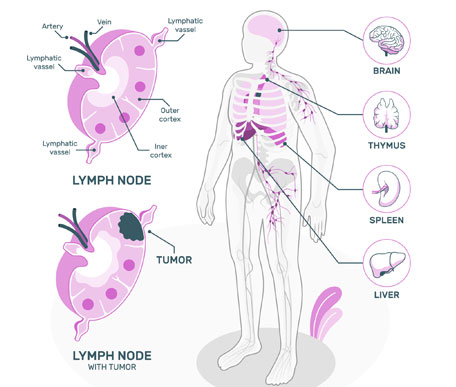


Lymphomas:
Lymphomas are cancers that originate in the lymphatic system, which is part of the body's immune system. There are two main types of lymphoma: Hodgkin lymphoma (HL) and non-Hodgkin lymphoma (NHL).
Symptoms of Lymphomas:
- Enlarged lymph nodes, which may be painless
- Fever
- Night sweats
- Unexplained weight loss
- Fatigue
- Itchy skin
- Shortness of breath or cough (if the lymphoma affects the chest)
Treatment for Lymphomas:
- Treatment for lymphomas depends on the type, stage, and other factors such as the patient's overall health and preferences.
- Common treatments include chemotherapy, radiation therapy, immunotherapy, targeted therapy, and stem cell transplant.
- For Hodgkin lymphoma, a combination of chemotherapy and radiation therapy is often used, with targeted therapy or immunotherapy as options for refractory or relapsed cases.
- Non-Hodgkin lymphomas have a more varied treatment approach, with chemotherapy, immunotherapy (such as rituximab), targeted therapy (such as tyrosine kinase inhibitors), and radiation therapy used depending on the subtype and stage of the disease.
Myeloma:
Multiple myeloma, often simply called myeloma, is a cancer of plasma cells, a type of white blood cell that produces antibodies. It primarily affects bone marrow and bone.
Symptoms of Myeloma:
- Bone pain, especially in the spine or ribs
- Weakness or numbness in the legs
- Fatigue
- Frequent infections
- Unexplained weight loss
- Easy bruising or bleeding
- Excessive thirst and urination (if the myeloma affects the kidneys)
Treatment for Myeloma:
- Treatment for myeloma depends on factors such as the stage of the disease, the patient's overall health, and whether they are eligible for a stem cell transplant.
- Common treatments include chemotherapy, targeted therapy (such as proteasome inhibitors or immunomodulatory drugs), corticosteroids, and immunotherapy.
- Stem cell transplant, either autologous (using the patient's own stem cells) or allogeneic (using donor stem cells), may be considered for eligible patients.
- Supportive therapies such as bisphosphonates may be used to strengthen bones and reduce the risk of fractures.
In both lymphomas and myeloma, treatment decisions are made based on individual factors, and patients may receive a combination of therapies tailored to their specific needs. Early detection and prompt treatment can help improve outcomes and quality of life for individuals with these blood cancers.